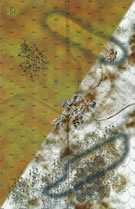|
|
|
Total |
| Side 1 |
0 |
| Draw |
0 |
| Side 2 |
1 |
|
Total |
| Side 1 |
0 |
| Draw |
0 |
| Side 2 |
1 |
|
Total |
| Side 1 |
0 |
| Draw |
0 |
| Side 2 |
0 |
|
| Overall Rating, 1 vote |
|---|
|
|
|
Scenario Rank:
--- of 940 |
| Parent Game |
Land Cruisers |
| Historicity |
Alt-History |
| Date |
1940-09-10 |
| Start Time |
06:00 |
| Turn Count |
32 |
| Visibility |
Day |
| Counters |
89 |
| Net Morale |
0 |
| Net Initiative |
2 |
| Maps |
2: 22, 24 |
| Layout Dimensions |
56 x 43 cm
22 x 17 in |
| Play Bounty |
182 |
| AAR Bounty |
227 |
| Total Plays |
1 |
| Total AARs |
0 |
|
Introduction
|
|
Brushing aside the German frontier forces, the French spearhead crashed into serious opposition a few kilometers further on. Per doctrine, the mechanized forces were to push until the opposition stiffened and then to make way for the infantry and their ample artillery to create a penetration. Once the penetration had been gained, the mechanized forces would be unleashed again and the cycle would repeat until the Germans could not recover or the artillery ammunition ran out.
The Groener Line had been built by Germany in the 1930’s to slow a French advance long enough to allow time for full mobilization. German war planners did not expect their fixed fortifications to stop a French assault forever, but did believe they could hold up an invading army for some time. La guerre éclair presented an unforeseen twist to the campaign. It was Halder’s job to buy time for the follow on forces to arrive and mobilization to continue.
|
|
Conclusion
|
|
Backed by massive artillery and air support, the French infantry and their infantry-support tanks fought their way through the German fortified line. The Imperial German forces fought desperately to gain time for the mobilization to complete. It became apparent that, if the Germans hoped to seal the French breakthrough they would have to commit their own armored reserves.
Halder reported to his Army commander, Feodor von Bock, that the time had come to send forward the mobile reserves. After a single full day of full-scale war, no knowledgeable German general thought their own tanks could stand up to those of the French. Yet, what else was there to do?
|
|
Additional Notes
|
|
Use French Casemates for German. |
Display Relevant AFV Rules
| AFV Rules Pertaining to this Scenario's Order of Battle |
- Vulnerable to results on the Assault Combat Chart (7.25, 7.63, ACC), and may be attacked by Anti-Tank fire (11.2, DFT). Anti-Tank fire only affects the individual unit fired upon (7.62, 11.0).
- AFV's are activated by tank leaders (3.2, 3.3, 5.42, 6.8).
They may also be activated as part of an initial activating stack, but if activated in this way would need a tank
leader in order to carry out combat movement.
- AFV's do not block Direct Fire (10.1).
- Full-strength AFV's with "armor efficiency" may make two anti-tank (AT) fire attacks per turn
(either in their action segment or during opportunity fire) if they have AT fire values of 0 or more
(11.2).
- Each unit with an AT fire value of 2 or more may fire at targets at a distance of between 100% and 150% of its
printed AT range. It does so at half its AT fire value. (11.3)
- Efficient and non-efficient AFV's may conduct two opportunity fires per turn if using direct fire
(7.44, 7.64).
Units with both Direct and AT Fire values may use either type of fire in the same turn as their opportunity fire,
but not both (7.22, 13.0).
Units which can take opportunity fire twice per turn do not have to target the same unit both times (13.0).
- Demoralized AFV's are not required to flee from units that do not have AT fire values (14.3).
- Place a Wreck marker when an AFV is eliminated in a bridge or town hex (16.3).
- AFV's do not benefit from Entrenchments (16.42).
- AFV's may Dig In (16.2).
- Closed-top AFV's: Immune to M, M1 and M2 results on Direct and Bombardment Fire Tables. Do not take step losses from Direct or Bombardment Fire. If X or #X result on Fire Table, make M morale check instead (7.25, 7.41, 7.61, BT, DFT).
- Closed-top AFV's: Provide the +1 modifier on the Assault Table when combined with infantry. (Modifier only applies to Germans in all scenarios; Soviet Guards in scenarios taking place after 1942; Polish, US and Commonwealth in scenarios taking place after 1943.) (ACC)
- Tank: all are closed-top and provide the +1 Assault bonus, when applicable
|
Imperial Germany Order of Battle
| 1 Errata Item |

|
In 1940: Fall of France, the units show Direct Fire. All units are Indirect Fire.
|



 LaCr001
LaCr001 
























